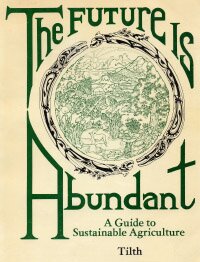
The Future is Abundant
A Guide to Sustainable Agriculture
Tilth Producers of Washington Home | WA Tilth Assoc. | Conference | Directory | Journal | Placement Service | Calendar | Action Alerts
Legislative Update | Bulletin Board | Classifieds | Questions on Agriculture? | Photo Gallery | Links | Contact Us | Join Now | Volunteer

No account of sustainable agriculture in the Northwest would be complete without a visit with Cahil in one of his Seattle gardens. His gardens do not have the conventional beauty of rational order, with neat rows of plants and naked brown soil. His gardens, and those inspired by them throughout the city, have the beauty of natural order. Each embodies a complex ecology, established through conscious yet intuitive understanding.
"Gardening is not like a chess game," he says. "There's no sense of what's coming, or what's happened before. Everything is right in front of you. When the gardener does act, it must be with 100% concentration." This sounds more like the advice of a yoga master or spiritual teacher than a gardener, but there is no contradiction. Cahil comes to gardening from a yoga/spiritual background.
The appearance of Cahil's garden is that of a small forest. The plants are so unusual that one cannot be sure offhand what most of them are. Some are simply perennialized versions of common annual vegetables, such as three-year-old broccolis and kales. Others are wild plants like nettle and mallow which Cahil has collected on his foraging trips through the urban wilderness.
"Most of what I eat from plants are flowers, or buds that would be flowers if I left them, or seed pods. In the stalk and leaf-making season, I eat the outer leaves." Cahil states that the main work in his gardens is "browsing," harvesting the edible parts. In this way, he keeps his radishes producing succulent pods, his kales producing spicy edible flowers.
When it comes to tillage, Cahil's ideas are just as unconventional, but sensible. Digging potatoes is one example of what he feels is an appropriate form of tillage. Weeding is another example. "Sometimes," he says, "I do tillage by pulling out morning glory roots. That tills the soil beautifully for planting peas in early spring."
In addition, Cahil uses mulch whenever possible. Over time, the end product is like a forest floor--loose and rich, diggable with the hands. His "urban food forest" gives plants a chance to become adapted to their immediate environment. In Cahil's term, they've mongrelized. "I want plants to become mongrels, I want them to hybridize, to cross-breed right away, instead of keeping those lines pure...I like plants that can take care of themselves, so that the garden could conceivably be there forever, taking care of itself without me."
Cahil is a teacher. He teaches how to live consciously, caringly, holistically. His garden is a teaching metaphor, but it is also an ongoing experiment on how to raise food without creating soul- and soil-depleting environments. "Any other kind of work in my book is meddling with nature."
What is Cahil's ultimate vision for the city garden? "I'm doing this in order to feed people, birds, insects, rodents, worms, beetles and spiders. My idea is to provide a healthy environment for everyone. There can be plenty of food and you don't have to worry about predators. A jungle-like environment provides forage for lots of different creatures. We keep each other's balance, with a little help and guidance from nature. I literally want to create a Garden of Eden on the physical plane."
Tilth Producers of Washington Home | WA Tilth Assoc. | Conference | Directory | Journal | Placement Service | Calendar | Action Alerts
Legislative Update | Bulletin Board | Classifieds | Questions on Agriculture? | Photo Gallery | Links | Contact Us | Join Now | Volunteer